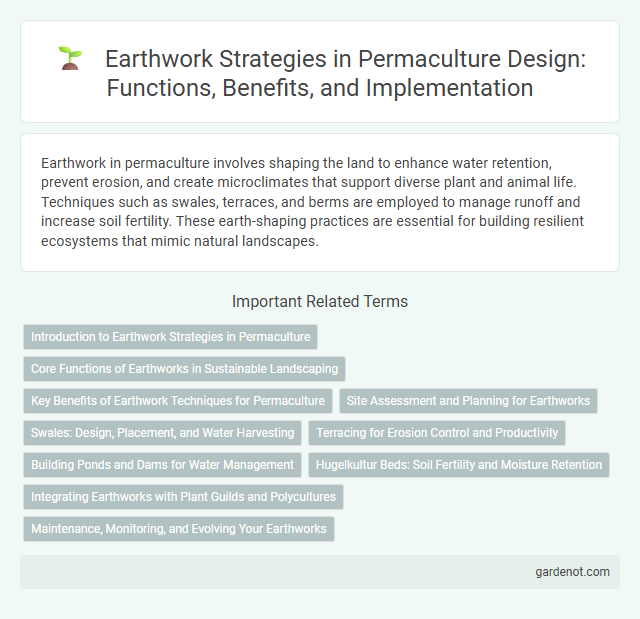Earthwork in permaculture involves shaping the land to enhance water retention, prevent erosion, and create microclimates that support diverse plant and animal life. Techniques such as swales, terraces, and berms are employed to manage runoff and increase soil fertility. These earth-shaping practices are essential for building resilient ecosystems that mimic natural landscapes.
Introduction to Earthwork Strategies in Permaculture
Earthwork strategies in permaculture involve reshaping the land to enhance water retention, reduce erosion, and improve soil fertility by creating swales, terraces, and keyline patterns. These techniques optimize natural water flow and promote sustainable land use, enabling productive ecosystems that support diverse plant and animal life. Implementing earthworks fosters long-term resilience and aids in restoring degraded landscapes by mimicking natural land contours.
Core Functions of Earthworks in Sustainable Landscaping
Earthworks in sustainable landscaping primarily focus on water management, soil conservation, and habitat creation, enhancing overall ecosystem health. Techniques such as swales, terraces, and berms capture and slow runoff, improving groundwater recharge while reducing erosion. These earth-shaping methods support plant growth, increase biodiversity, and contribute to long-term landscape resilience.
Key Benefits of Earthwork Techniques for Permaculture
Earthwork techniques in permaculture enhance soil structure and water retention by creating swales, basins, and terraces that reduce erosion and promote groundwater recharge. These earthworks increase biodiversity by establishing microhabitats and improve crop yields through optimized nutrient cycling and moisture management. Implementing contour bunding and keyline design maximizes land productivity while supporting sustainable ecosystem restoration.
Site Assessment and Planning for Earthworks
Site assessment for earthworks in permaculture involves analyzing soil type, topography, drainage patterns, and existing vegetation to determine optimal earth-moving strategies. Planning incorporates contour mapping, water flow direction, and erosion risk to design swales, berms, and terraces that enhance water retention and soil fertility. Detailed evaluation of microclimates and site-specific ecological factors ensures sustainable and efficient earthwork implementation.
Swales: Design, Placement, and Water Harvesting
Swales are key permaculture earthworks designed to capture and infiltrate water by following the natural contour lines of a landscape, thereby reducing soil erosion and increasing water retention. Proper placement on contour lines ensures that swales slow runoff, allowing water to percolate into the soil and support nearby vegetation, enhancing ecosystem resilience. Optimal swale dimensions and integration with other water harvesting techniques maximize groundwater recharge and promote sustainable land management.
Terracing for Erosion Control and Productivity
Terracing in permaculture involves reshaping sloped land into a series of stepped flat areas to reduce soil erosion and enhance water retention. This earthwork technique significantly slows runoff, preventing nutrient loss and allowing for more productive planting zones. By stabilizing steep terrain, terraces create microclimates that support diverse crops and increase overall site productivity.
Building Ponds and Dams for Water Management
Building ponds and dams in permaculture enhances water retention, reduces erosion, and supports biodiversity by creating microclimates. Proper design incorporates contour mapping and swales to maximize water catchment and infiltration. These earthworks optimize water management, improve soil moisture, and sustain agricultural productivity.
Hugelkultur Beds: Soil Fertility and Moisture Retention
Hugelkultur beds enhance soil fertility by decomposing wood layers that release essential nutrients, fostering rich microbial activity crucial for healthy plant growth. Their raised structure improves moisture retention, reducing irrigation needs by capturing rainwater and slowly releasing it into the soil. This method creates a sustainable, self-sufficient environment ideal for permaculture systems focused on resilience and productivity.
Integrating Earthworks with Plant Guilds and Polycultures
Integrating earthworks with plant guilds and polycultures enhances soil fertility, water retention, and microclimate stability by creating synergistic plant interactions within contour swales, keyline designs, and berms. Strategic placement of nitrogen-fixing plants, dynamic accumulators, and ground covers in earthwork structures promotes nutrient cycling and reduces erosion, optimizing ecosystem functions. This holistic approach supports resilient agroecosystems, increases biodiversity, and maximizes yields in permaculture landscapes.
Maintenance, Monitoring, and Evolving Your Earthworks
Regular maintenance of earthworks ensures optimal water retention, soil stability, and erosion control, preventing structural failures in permaculture systems. Monitoring involves consistent observation of vegetation health, water flow patterns, and soil moisture levels to identify issues early and adapt management practices. Evolving earthworks through iterative adjustments based on ecological feedback enhances resilience, promotes biodiversity, and supports sustainable land regeneration.
Earthwork Infographic

 gardenot.com
gardenot.com